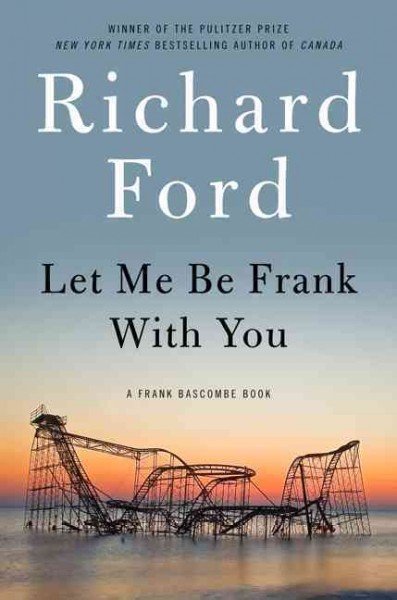The Lay of the Land Richard Ford (2006)
Let Me Be Frank With You Richard Ford (2014)
These books are the third and fourth in Richard Ford’s tetralogy that follows the adult life of the character Frank Bascombe. Some background:
- In the first novel of the series, The Sportswriter (1986), Frank is deep in grief over the death of his young son and his subsequent divorce from his wife. Although he had wanted to write fiction, he’s turned to writing about sports to support himself.
- In Ford’s second offering, Independence Day (1995), Frank has changed careers and is selling real estate in New Jersey. This novel, which won both the Pulitzer Prize and the PEN/Faulkner Award for Fiction, is set at the titular American holiday.
- Holiday celebrations, which often cause simmering family tensions to boil over, figure prominently in all four books about Frank. An Easter dinner is a key scene in The Sportswriter, and the two books that I’m reviewing here are set at Thanksgiving (The Lay of the Land) and during the Christmas season (Let Me Be Frank With You).
In The Lay of the Land, the political backdrop is the contested presidential election of 2000, which was still not decided by Thanksgiving of that year, so tension and accusation and fear are in the air. As always, Ford’s focus is on Frank Bascombe’s inner life, narrated in first person. Speaking to his adult daughter, Clarissa, Frank says, “I’ll commit suicide before I keep a fucking diary. Diaries are for weaklings and old queer professors. Which I’m not.” (240) And yet this entire novel is like a very detailed, highly reflective diary. Frank is now fifty-five and married to his second wife, Sally Caldwell. He’s recently been treated for prostate cancer at the Mayo Clinic. You might find Frank’s trips to the toilet tiresome, but his need to empty his bladder frequently is a constant reminder of the threat of death that hangs over him.
He calls this phase of his life “the Permanent Period—no fear of future, life not ruinable, the past generalized to a pleasant pinkish blur.” (249) There’s a fatalism to Frank’s categorization of late middle age in this way. He’s still selling real estate, though he does have occasional regrets about giving up his dream of writing fiction. He rationalizes: “Realtors share a basic industry with novelists, who make up importance from life-run-rampant just by choosing, changing and telling. Realtors make importance by selling, which is better-paying than the novelist’s deal and probably not as hard to do well.” (84)
The Lay of the Land is expansive, exhilarating, and sometimes exhausting. It’s the work of an accomplished prose stylist who gives us a view into an ordinary life on ordinary and non-so-ordinary days. The exquisite specificity with which Frank describes his surroundings contrasts with his inability to connect with some people. These people are sometimes fairly conventional—like Sally—and sometimes quite unusual—like the Tibetan Buddhist with the Americanized name, Mike Mahoney, “a five-foot-three-inch, forty-three-year-old realty dynamo” (14) who works for Frank’s real estate office on the Jersey Shore.
The theme of Frank’s relationships is developed further in the most recent volume of the tetralogy, Let Me Be Frank With You, four linked short stories in which Frank Bascombe meets with four different people from his past. The year 2012 is coming to an end, and New Jersey is reeling from the October onslaught of Hurricane Sandy. All around him is destruction, but Frank has survived that cancer diagnosis so far, and in retirement he’s withdrawn more into himself. “For months now—and this may seem strange at my late moment of life (sixty-eight)—I’ve been trying to jettison as many friends as I can, and am frankly surprised more people don’t do it as a simple and practical means of achieving well-earned, late-in-the-game clarity. Lived life, especially once you hit adulthood, is always a matter of superfluity leading on to less-ness.” (187) He provides a summation of how he sees his own character: “. . . a man who doesn’t lie (or rarely), who presumes nothing from the past, who takes the high, optimistic road (when available), who doesn’t envision the future, who streamlines his utterances (no embellishments), and in all instances acts nice.” (140-41) Well, Frank may think he’s always “nice,” but readers can catch him in some unkind deeds.
I found Let Me Be Frank With You less masterful than The Lay of the Land, and I noted a few discontinuities, such as Sally’s birthday moving from summer to near Christmas. Still, Ford’s trademark particularization pulls you in, letting you gape at the damage wrought by the hurricane (and by the previous collapse of the real estate market in 2008), letting you linger on the inevitable wrinkles in the aging faces of the characters.
The Frank Bascombe tetralogy is by turns hilarious and devastatingly serious, honest and deceptive, reflecting the life of one American man—and a slice of American history.



